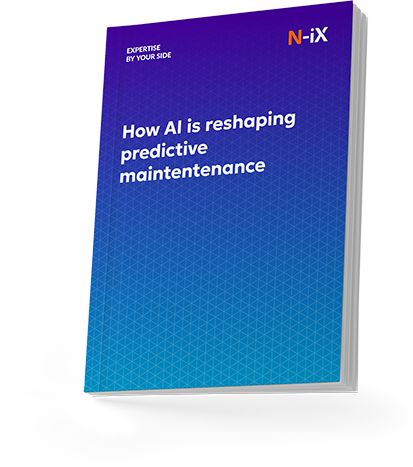Modern supply chains are too complex and too fast-moving to be managed through static reports or siloed systems. With 76% of supply chain executives experiencing more frequent disruptions in recent years, the need for analytics-driven resilience has become clear [1]. Traditional reporting and delayed decision-making no longer meet the demands of volatile supplier networks, shifting logistics constraints, and rising customer expectations.
To meet these challenges, more enterprises are investing in custom logistics and supply chain software development paired with modern Business Intelligence (BI) services. These solutions help unify fragmented systems, surface real-time insights, and enable proactive decisions across procurement, production, transportation, and fulfillment.
Business Intelligence in supply chain applies tools such as dashboards, data platforms, and predictive models to monitor, forecast, and optimize operations across sourcing, logistics, and delivery. Integrating BI into supply chain operations provides organizations with the infrastructure to make faster decisions, optimize resource allocation, and adapt effectively to change.
Why do you need Business Intelligence in supply chain?
As organizations mature digitally, Business Intelligence has shifted from a reporting utility to a strategic enabler. With the right data foundation in place, supply chain teams gain continuous visibility into their operations, allowing them to identify and correct inefficiencies, mitigate risks, and better serve their customers. However, the growing complexity of global trade networks and supplier ecosystems makes achieving this visibility increasingly difficult.

KPMG reports that over half of supply chain leaders are more concerned about visibility than a year ago, and 61% now identify it as a top strategic objective. BI systems directly support this agenda by consolidating data from ERP, TMS (transportation management systems), WMS (warehouse management systems), and CRM systems into unified dashboards, delivering real-time operational transparency across the chain.
Together, these priorities demonstrate that BI adoption is no longer a question of “if,” but rather “how fast.” Business Intelligence provides the architecture necessary to achieve these goals, enabling data-driven procurement, logistics optimization, and service-level accountability.
Business Intelligence is essential when your supply chain needs:
To forecast demand accurately
Business Intelligence platforms consolidate historical sales data, market signals, and seasonal trends into unified forecasting models, enabling more accurate predictions. Supply chain teams use these insights to align procurement and production with anticipated demand, minimizing the risk of stockouts or overproduction.
To track supplier performance
According to the research by KPMG, 43% of companies lack clear visibility into even their Tier 1 suppliers, underscoring the need for centralized, analytics-driven supplier monitoring [2]. BI dashboards offer real-time access to key supplier indicators, including delivery timeliness, defect frequency, and order accuracy. Procurement and logistics leaders rely on these metrics to evaluate vendor reliability, mitigate disruptions, and enforce performance standards.
Read more: Supply chain analytics: Making data work for you
To reduce excess inventory
Analytics-driven inventory management enables organizations to match replenishment with actual consumption patterns. Business Intelligence in supply chain provides visibility into stock levels, turnover rates, and demand variability, allowing businesses to eliminate overstocking, reduce holding costs, and maintain optimal availability.
To optimize delivery routes
Integrated BI systems analyze logistics data across TMS, route history, and service benchmarks to provide comprehensive insights. Operations teams apply these insights to enhance route planning, optimize fleet utilization, and minimize transportation expenses while upholding SLA commitments.
To detect risk early
Predictive models built into BI platforms identify early indicators of potential failure across supply, production, and distribution layers. Leading signals, such as delayed shipments, capacity gaps, or supplier non-compliance, trigger alerts that enable preemptive action.
Discover how AI is taking predictive maintenance to a next level—get the guide now!


Success!

To improve SLA compliance and customer experience
Performance metrics from fulfillment, logistics, and customer service channels are centralized through BI. Teams monitor SLA (service level agreements) adherence, resolve delivery issues proactively, and continuously improve accuracy and responsiveness, directly impacting customer satisfaction and retention.

Read more: A quick guide to supply chain digital transformation
What can you achieve with Business Intelligence in the supply chain?
Business Intelligence systems can be tailored to address specific supply chain challenges across different industries. Below are the examples of how BI delivers value by function:
Retail: Promotion forecasting and return reduction
Retailers use BI to enhance promotional planning and post-campaign analysis. By analyzing historical sales, customer behavior, and seasonal trends, BI tools can predict which promotions are likely to drive demand without overstocking. Post-sale return patterns can be analyzed to identify root causes, such as product sizing issues, shipment delays, or mismatches with customer expectations, enabling corrective actions in sourcing, logistics, or product design.
Outcomes:
- Fewer stockouts during high-demand periods;
- Lower return rates and reverse logistics costs;
- Better merchandising and inventory turnover.
Read more: Retail supply chain analytics: technologies, applications, and benefits
Manufacturing: Production optimization and supplier risk monitoring
Manufacturers use Business Intelligence in supply chain to align production plans with actual demand signals and capacity constraints. Dashboards consolidate data from manufacturing execution systems (MES), ERP, and supply networks to identify bottlenecks and inefficiencies in real-time. Moreover, BI can track supplier reliability indicators, such as late deliveries, quality issues, or geopolitical exposure, to proactively manage risk and ensure continuity of supply.
Outcomes:
- Increased asset utilization;
- Reduced lead times;
- Proactive supplier intervention.
Logistics: Route optimization and SLA monitoring
For logistics providers, Business Intelligence tools integrate data from TMS, GPS, and carrier systems to enable dynamic route planning based on traffic, fuel costs, and delivery windows. They also monitor service level agreements by tracking shipment accuracy, delivery timeliness, and exception handling. These insights help reduce penalties, optimize resource allocation, and improve customer retention.
Outcomes:
- Reduced cost-per-mile and missed deliveries;
- SLA adherence with real-time alerts;
- Improved capacity planning.
Ecommerce: Warehouse accuracy and customer experience tracking
Ecommerce businesses use Business Intelligence in supply chain to maintain high accuracy in warehouse picking, packing, and shipping processes. Integration with WMS, order management, and customer service systems enables companies to track fulfillment speed, stock discrepancies, and customer satisfaction metrics, such as delivery accuracy and the Net Promoter Score (NPS). These insights directly impact retention and lifetime value.
Outcomes:
- Higher first-time delivery accuracy;
- Faster order cycle times;
- Customer experience insights improve the product and logistics.
Building a BI-ready supply chain: Implementation roadmap by N-iX
The successful implementation of Business Intelligence in supply chain management depends not only on tools, but also on a structured and well-sequenced implementation approach. At N-iX, we help enterprises transition from fragmented data landscapes to intelligent, insight-driven operations. Below is a roadmap we follow when supporting BI adoption in supply chain environments:
1. Assess data availability and quality
The starting point is a comprehensive audit of available data across various supply chain systems, including ERP, WMS, CRM, TMS, and external partner platforms. We evaluate not only the presence of data but also its structure, granularity, and historical depth. This step also identifies data gaps and inconsistencies that must be addressed before integration.
Key output: Inventory of data assets and data readiness scorecard
2. Unify and integrate data through a scalable architecture
Next, we design a modern data integration layer tailored to your ecosystem. Depending on your needs, we may deploy a cloud-based data warehouse for structured reporting, a data lake to store raw or semi-structured supply chain data, or a lakehouse architecture that combines the scalability of data lakes with the performance of warehouses. Our engineers build robust ETL pipelines, ensure schema consistency, and enable real-time synchronization across all connected systems.
Key output: Unified, query-ready data platform feeding analytics pipelines
3. Deploy role-specific dashboards and reporting layers
At this stage, we build customized dashboards and reporting interfaces for key supply chain functions: procurement, logistics, inventory, and fulfillment. These visualizations are connected directly to the integrated data architecture, offering real-time access to operational insights. We use tools such as Power BI, Tableau, or Looker to ensure clarity, speed, and secure access for each user group.
Key output: Real-time Business Intelligence in supply chain analytics
4. Introduce predictive models for planning and risk
After establishing descriptive analytics, we advance to predictive capabilities. At this stage, our teams implement models for demand forecasting, inventory optimization, supplier performance evaluation, and lead-time variability. These models are trained on historical trends and can be augmented with external datasets, such as weather forecasts, market indicators, or geopolitical data, to improve accuracy and support scenario planning.
Key output: ML-driven forecasting and scenario models embedded into planning workflows
5. Enable organizational adoption through workshops
Technology alone doesn’t ensure impact. N-iX supports adoption by training both decision-makers and operational teams on interpreting insights, exploring data independently, and embedding BI into routine workflows. We offer dedicated workshops and knowledge transfer sessions tailored to your specific needs.
Key output: Cross-functional BI adoption with reduced tool underutilization
6. Establish BI governance and sustainability
Finally, we help establish long-term governance frameworks that ensure data quality, clarity of ownership, and process accountability. This stage includes defining data stewardship roles, establishing KPI documentation, setting refresh cadences, and monitoring adoption metrics over time.
Key output: Sustainable, governed BI operating model with continuous improvement
Read more: Enterprise Business Intelligence: use cases and challenges
Common implementation challenges of Business Intelligence in supply chain and how N-iX solves them
Even with the right BI tools in place, many organizations fail to reach the full potential of Business Intelligence in their supply chain. Below are four recurring challenges and the best practices by N-iX to overcome them.
1. Data silos limit end-to-end visibility
In many organizations, data is fragmented across various platforms, including ERP, WMS, TMS, CRM, and legacy systems. These disconnected systems prevent unified reporting, make cross-functional analysis challenging, and hinder decision-making.
Solution by N-iX: Our teams design and implement centralized data architectures using cloud data lakes or data warehouse solutions, such as Snowflake, BigQuery, or Redshift. We integrate siloed systems through secure ETL pipelines to ensure that supply chain stakeholders have access to a consistent, consolidated view of operations.
2. Low data quality undermines insights
Missing fields, duplicates, inconsistent naming, outdated records, and other cases of poor data quality directly affect forecasting accuracy, supplier evaluations, and operational reporting. Without clean, trusted data, decision-makers lose confidence in the BI outputs.
Solution by N-iX: N-iX implements robust data validation rules and cleansing routines as part of the ETL process. Additionally, we help clients establish governance policies that define data ownership, enforce standards, and ensure ongoing data quality monitoring.
3. Tool underutilization limits ROI
Many companies invest in BI platforms but fail to achieve adoption beyond isolated power users. Without meaningful adoption across supply chain roles, the organization lacks the data-driven agility it needs.
Solution by N-iX: We develop tailored dashboards for specific functions, such as procurement, logistics, finance, and train teams on how to extract value from their data. Role-based enablement ensures every user sees only the insights relevant to their KPIs and decisions, increasing daily use and measurable impact.
4. Lack of business alignment weakens the BI strategy
When KPIs are defined in isolation, or without buy-in from operational and strategic teams, BI initiatives often fail to support real business goals. Misaligned metrics can lead to conflicting decisions and hinder cross-team collaboration.
Solution by N-iX: Our experts facilitate cross-functional KPI alignment workshops during project discovery to ensure seamless alignment. We work with supply chain, finance, IT, and executive stakeholders to co-define metrics that reflect enterprise priorities, ensuring BI serves as a shared source of truth, not a siloed reporting tool.
Wrap up
Business Intelligence has become indispensable for modern supply chains, which face volatility, complexity, and rising service expectations. From accurate demand forecasting and inventory optimization to supplier risk tracking and SLA monitoring, Business Intelligence in supply chain enables organizations to make informed, real-time decisions. However, the benefits of BI depend not only on tooling but also on data readiness, cross-functional alignment, and a structured implementation roadmap.
To achieve these outcomes, companies need a software development partner with deep expertise in both data engineering and supply chain operations. At N-iX, we bring 23 years of experience delivering enterprise-grade solutions, with over 2,400 professionals, among whom 200 are data experts. We’ve successfully delivered more than 60 data-driven projects across various industries, helping businesses unify fragmented systems, operationalize analytics, and build BI platforms that drive measurable impact. Whether you're modernizing your architecture or launching your first supply chain BI initiative, N-iX provides the technical capability and domain knowledge to deliver end-to-end success.
References
- Gartner - Key Characteristics of Supply Chain Analytics High Performers
- KPMG - The Future of Supply Chain
Have a question?
Speak to an expert




